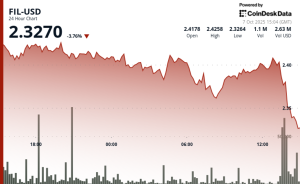Key Insights
- Boba Network is a multichain, optimistic rollup, Layer-2 scaling solution. Boba is live on Ethereum, Moonbeam, Avalanche, BNB, and Fantom.
- Boba’s main focus is on gaming, NFTs, and metaverse. Hybrid Compute is a key feature that allows developers to leverage existing Web2 tooling for more powerful computation and data usage.
- Boba Avax and Boba BNB officially launched in Q4. Boba Network has plans to expand to more L1s in 2023 to allow for seamless integration of existing and new games/metaverses.
- In Q4, Boba Ethereum’s market cap decreased by nearly 50%, and its daily transactions decreased by nearly 20%. Many of Boba’s new partnerships are not fleshed out enough to maintain or grow the user base right now.
- When blockchain gaming finally gets its time in the sun, Boba will be positioned to succeed in terms of both architecture and ecosystem.
Primer on Boba
Boba Network is a Layer-2 multichain scaling solution with a focus on gaming. Boba operates on Ethereum, Moonbeam, Avalanche, BNB, and Fantom, and it is maintained by Enya Labs. As an optimistic rollup (OR) based on Optimism’s codebase, Boba offers:
- Reduced gas fees
- Increased transaction throughput
- L1 security guarantees
- EVM compatibility for smart contracts, such as NFTs
This network also has unique features that set it apart from other ORs and Optimism forks:
- Hybrid Compute — the ability to connect to off-chain APIs
- Multichain focus
- Fast exit bridging to L1
- DAO governance
Boba’s combination of features — specifically Hybrid Compute — enables decentralized applications (dapps) to run at a fraction of the cost of L1 dapps, leverage off-chain computation via Web2 APIs, and provide the multichain solutions needed for blockchain gaming.
Key Metrics
The quantitative data in this report is focused on the Ethereum implementation of Boba Network, unless stated otherwise. Implementations on other chains lack viable data in many areas as they’ve only recently been deployed.
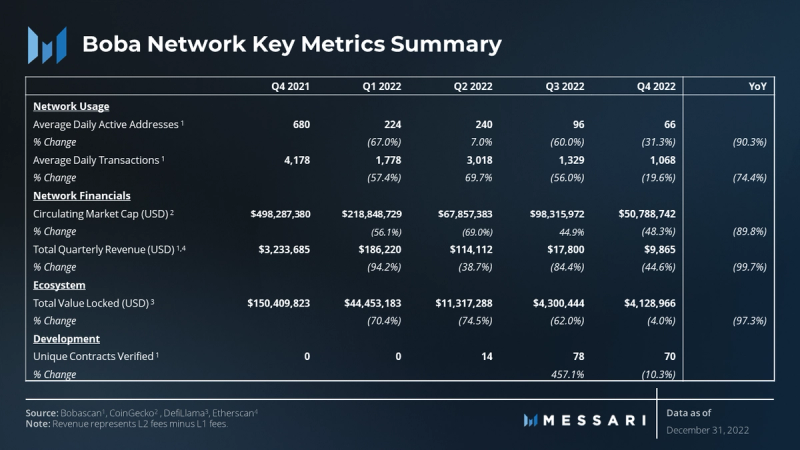
Performance Analysis
Network Usage and Financial Overview
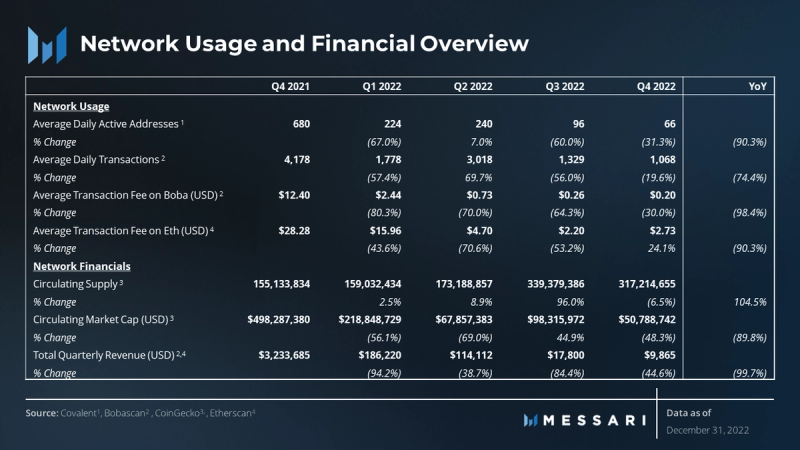
Boba Network’s usage and financials have been on a mostly uninterrupted decline since launch in Q4 2021. Daily active addresses and transactions have also continued to decline since Q2.
Circulating supply decreased by about 40,000 BOBA on December 2 because the unclaimed BOBA previously made available to OMG holders was returned to the treasury.
Due to these declines, TPS (transactions per second) has lost almost all of its significance. TPS followed the same trend as daily transactions during 2022, decreasing YoY by 74.4% from 0.05 TPS to 0.01 TPS. Boba is currently showing a low TPS because of low activity; however, it has the potential to support much higher TPS when users come and activity increases. Until then, TPS is not a noteworthy metric.
Similarly, transaction fees and revenue are not entirely representative of Boba’s success during times of low activity. Because L1 fees are incurred from batches being posted to the L1, optimal L2 transaction fees only occur when blocks are full with transactions. Boba Network claims transaction fees up to 100x cheaper than L1s, which could very likely be the case in a time of sustained high activity.

Moonbeam and Avalanche are two of the parent L1s for new Boba implementations launched in 2022. These new implementations are starting to see a bit of activity as games and other dapps move over to the L2. Boba is the first L2 available for most of these alt-L1s so we can expect more dapps, even those outside of gaming and metaverse, to take advantage of Boba’s reduced fees in 2023.
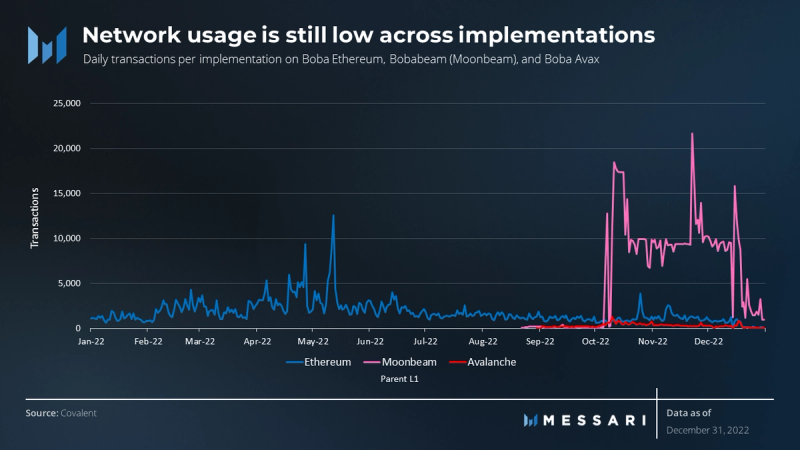
There’s much more variation between implementations in terms of daily transactions. This difference is due to block times. Bobabeam (Moonbeam) averages a new block almost every 10 seconds, while Boba Avax, Boba BNB, Boba Opera (Fantom), and Boba Ethereum all have block times between 3 and 10 minutes. Every new block requires a transaction, and blocks are produced at regular intervals whether or not any transactions occur, which heavily inflates the metric for Boba on Moonbeam with its faster block time.
Ecosystem and Development Overview
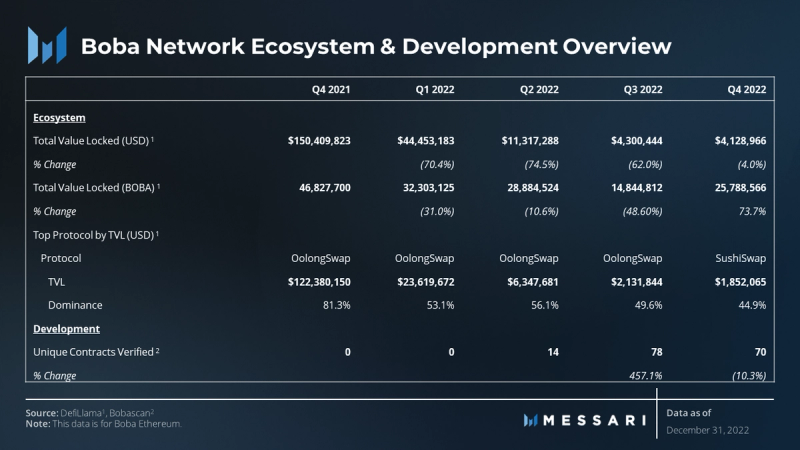
Boba Network’s TVL is down 97.3% YoY to ~$4 million. On alt-L1 implementations such as Boba Avax and Boba BNB, TVL is ~$41,000 and ~$14,000, respectively. However, the absence of a DeFi ecosystem is largely irrelevant to the Boba Network thesis. Boba won’t rely on DeFi forks to bring in users; rather, its scaling will be the result of the unique developing capabilities brought on by Hybrid Compute.
Gaming
Boba Network’s ecosystem continues to focus on gaming and metaverse, even though they are still in early stages. Many new Boba games, such as EvoVerses, are still in beta stages and don’t yet have many users. Until these games gain a large user adoption, they won’t have any significant impact on Boba’s metrics. Even at that point, gaming metrics can’t be measured like DeFi metrics, which use TVL as the main benchmark. Instead, NFT volumes will likely be a representative metric of gaming activity in the future.
Boba Network has now brought its benefits of low fees and features to Binance games. Since Boba BNB’s launch, the following games have partnered with Boba:
NFTs
While there are some “classic” profile picture (pfp) NFT projects on Boba, such as BobaPunks, future NFT volume is expected to come from gaming. Pfp NFT collections have not seen much adoption on Boba, with BobaPunks’ floor being 0.03 ETH on tofuNFT. Similar to other L2s, Boba’s NFTs can be found on marketplaces that support NFTs for the underlying L1s, such as OpenSea for Ethereum and Avalanche.
There are already some existing NFT collections that are part of blockchain games newly on Boba, such as the Cosmic Wizards from Cosmic Universe on Avax. Because NFTs are an integral part of many blockchain games, there will be more on Boba as games mature past beta stages.
DeFi
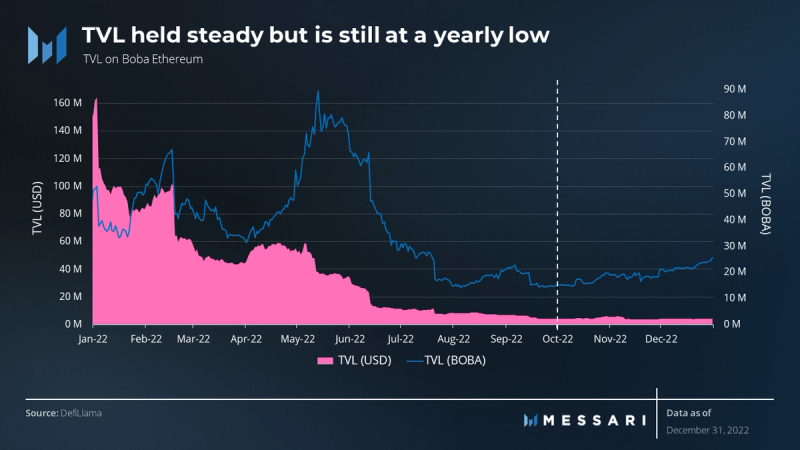
SushiSwap overtook OolongSwap in Q4 as the most dominant source of TVL in Boba Network’s DeFi ecosystem. This marks a shift from dominance in Boba-native DEXs to SushiSwap. which is an Ethereum-native DEX that migrated over. We can expect to see more DeFi migrations, such as Uniswap, on Boba soon.
SushiSwap and Symbiosis Finance have also deployed on Boba Avax and Boba BNB, although the TVL on each implementation is negligible — about $50,000 combined. DEXs and DeFi tools are not an onboarding priority, but their presence is certainly welcome — especially since the EVM-compatibility makes the deployments low-hanging fruit.
TVL (USD) remained stable through Q4. TVL (BOBA), on the other hand, increased by 73.7% QoQ, which was offset by the BOBA token dropping in value from $0.29 to $0.16.
Qualitative Analysis
Multichain Approach
Boba instances on BNB, Avalanche, Moonbeam, and Fantom are barely seeing 100 daily active users (DAU), but they do have teams — e.g., EvoVerses, Cosmic Universe, Homie Wars — migrating over from L1s to their respective L2s. Boba Network has plans to expand to more L1s in 2023 to allow for seamless integration of existing and new games/metaverses. Even though some alt-L1s such as Avalanche already have cheaper fees than Ethereum, those fees can be further reduced by another 30x, according to Boba Network.
Boba users and protocols can transfer liquidity easily with Boba Gateway. Boba has recently been added to Beamer Bridge, allowing for easy transfers between other L2s such as Optimism. In the spirit of flexibility, Boba has also integrated with on-/off-ramp Banxa for users to more easily swap between fiat and BOBA.
Hybrid Compute and Gaming
Boba Network aims to be the leading solution for gaming and metaverse via its Hybrid Compute feature. This feature is intended to solve the problem of closed-off blockchain ecosystems. As it stands, blockchains cannot use any data or compute from outside of their ecosystem without an API or oracle. With Hybrid Compute, blockchain developers would be able to:
- Create advanced algorithms that are typically too expensive to run on-chain.
- Get millisecond response times.
- Generate random numbers and other resources that are risky to generate in decentralized computational environments due to security concerns.
- Access low-cost storage, image, and audio processing.
With Hybrid Compute, developers can leverage legacy Web2 systems and solutions to build higher-quality blockchain games. For example, Boba Avax adopted Avalanche games such as METAFORRA, Cosmic Universe, and EvoVerses, which can now leverage off-chain compute and Web2 APIs.
API3 announced that it will be deploying QRNG on Boba, a quantum random number generator. Many aspects of gaming rely on random numbers, which are notoriously difficult to generate on closed blockchain systems.
L2 Wars
Optimism and Arbitrum, fellow optimistic rollups, still heavily dominate the L2 space with ~52% and ~29% of the TVL market share, respectively. Boba Network holds ~0.3% of the L2 TVL market share — about $4 billion. The number of daily active addresses, protocols deployed, and unique contracts on Boba are similarly behind the competition.
With many zero-knowledge rollups (ZKRs) approaching mainnet, such as zkSync and Scroll, Boba’s ‘fast exit’ will no longer offer an advantage. ORs typically take seven days for withdrawals, but ZKRs only take a few minutes and would match Boba’s speed.
However, DeFi and withdrawal speed are not Boba’s niche. Boba remains the only multichain L2 and the only L2 on Avax, BNB, and Fantom. More importantly, Boba’s Hybrid Compute still doesn’t face any direct competition.
Roadmap
Aside from Hybrid Compute advancements and multichain scaling, Boba’s 2023 plans include:
- Parallel transactions: Executing transactions in parallel allows for a higher TPS.
- Account abstraction: Abstracting child accounts from a single main account allows the main account to do things such as pay fees for its derived contract accounts.
- Escape hatches to L1: Escape hatches offer greater security guarantees for users to remove funds from L2 without needing to rely on the Sequencer.
Closing Summary
Boba Network is firmly behind some of the more established competition in terms of general-purpose scaling solutions, but Boba is not taking the generalist approach. Boba remains the only multichain L2 and the only L2 on Avax, BNB, and Fantom. More importantly, Boba’s Hybrid Compute still doesn’t face any direct competition. With its emphasis on multichain scaling and Hybrid Compute, Boba is an attractive home for blockchain game developers, as seen in its new partnerships.
In Q4 2022, Boba Ethereum’s market cap decreased by nearly 50%, and its daily transactions decreased by nearly 20%. Newer implementations, such as Boba Avax and Bobabeam (Moonbeam), are just starting to see their first user activity, but their DAU numbers are still at Boba Ethereum’s yearly low. Although Boba lacks network activity, the protocol is building and expanding so it will be ready when the demand for crypto gaming inevitably arrives.
Although Boba has pursued a strategy of specialization in its offering, the protocol has continued its efforts to reach a large audience by securing specific partnerships across chains. When blockchain gaming finally gets its time in the sun, Boba will be positioned to succeed in terms of both architecture and ecosystem.

